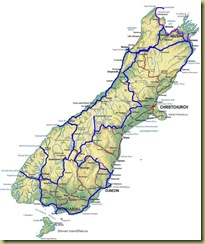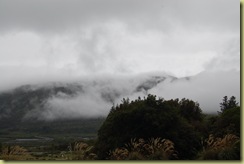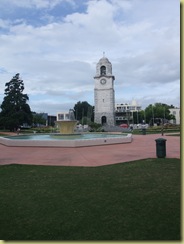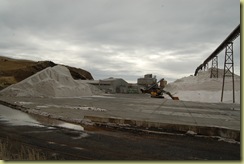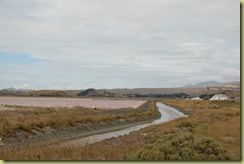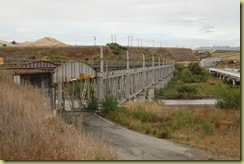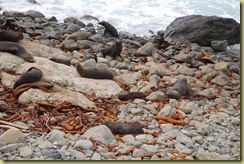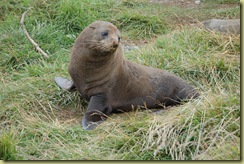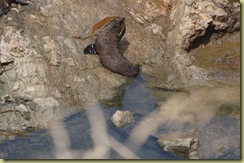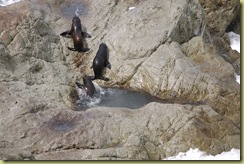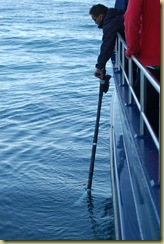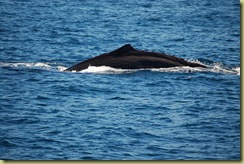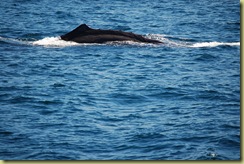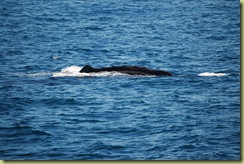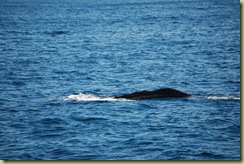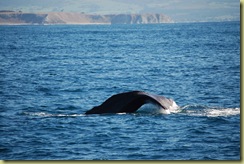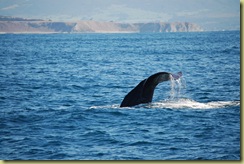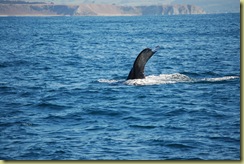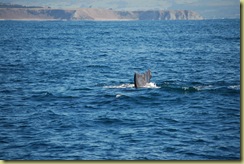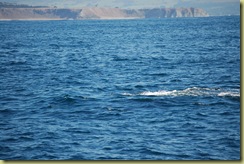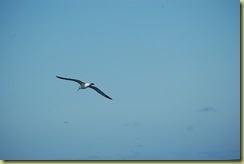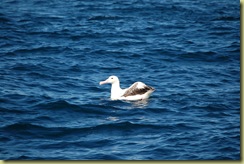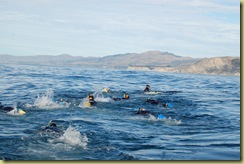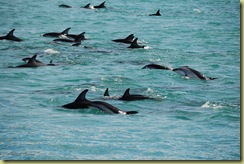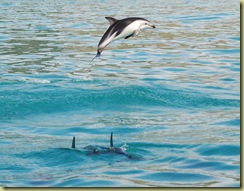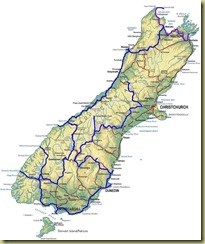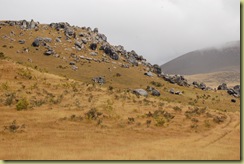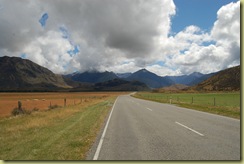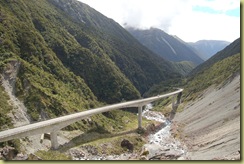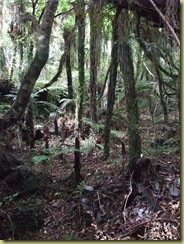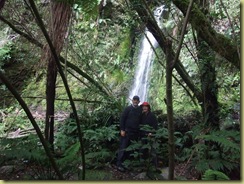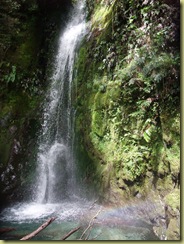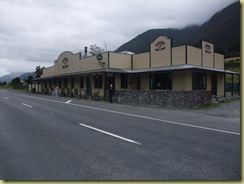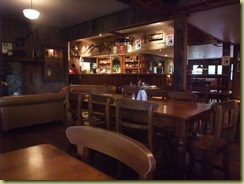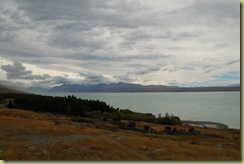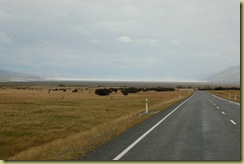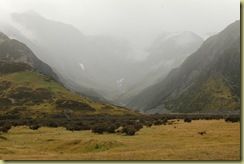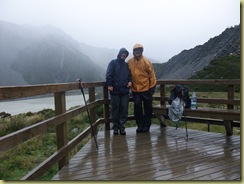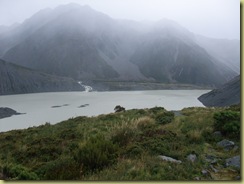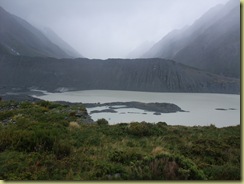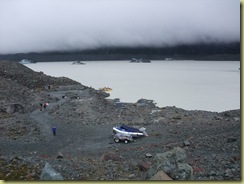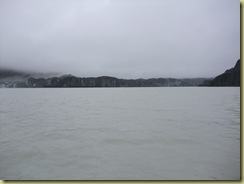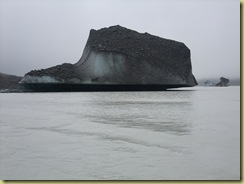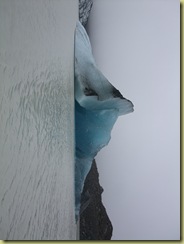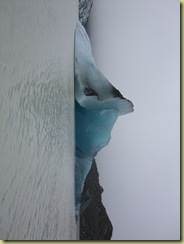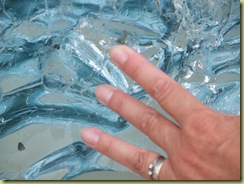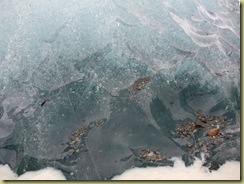There are not many choices of route from Jackson (near Greymouth) back over to the east coast. Having already driven many of the roads, we are heading north and then east in a general “north of Christchurch” direction, the exact route being decided when we find out how easy it is to get fuel (there have been some shortages because of the earthquake).
Leaving in the rain (does it do anything else on the West
Coast we wonder), we head north and soon find that fuel is readily available and so decide to take the longer route choice to Blenheim. Although this takes us partly back along the same road we were on some three weeks earlier, we soon turn off into the Alpine Region – it really does feel like the French Alps and then into the endless vineyards of the Marlborough Region. One thing we do notice is the first traces of autumn in the leaves.
Blenheim is not regarded as somewhere of any value by our guide books, the emphasis being on the vineyards around it. We must say that its outskirts are truly appalling being factory warehouse estate design run riot and it is the only town we have been to in New Zealand where rubbish is very noticeable on the streets.
Seymour Square is said to be the best thing in town together with the clock tower so here is a picture of them:
We think that the trees in the square are far more interesting and look like they are straight out of one of the
 |  |
Narnia books and that they will talk to us at any moment.
Our primary destination is Kaikoura, a town a bit south but still on on the east coast which has become the de facto Whale Watching / Dolphin Swimming capital of New Zealand and we intend to do at least one of these. The advice is that any activity here is very weather dependent so we are allowing a spare day in case of cancellation (in which case we will go tramping).
On the way south we pass a salt works at Lake Grassmere – the source of a lot
of New Zealand’s salt. Here the salt is sea salt and is produced by evaporation in large salt lakes – the saltier the
water, the pinker the colour.
There is also what would have been a fairly unique bridge were it still in full operation – the standard single track bridge across a river (we have come to quite like these in New Zealand) but this time with a railway track on top (as against down the middle of the road which we experienced elsewhere). When opened, this bridge was greeted with such joy that Blenheim had a day’s holiday for everyone in the town and half of the town went down to the bridge to see the first traffic cross it. Now it just carries the railway.
We also meet Fur Seals again at Opau Point – apparently
the largest colony on the east coast.
There are indeed large numbers but some tourists seem to be getting far to close to them or between them and the sea and this
makes them unsettled.
The pups seem to be playing “killing large chunks of kelp”
or learning swimming skills in saltwater pools in the rocks.
Kaikoura used to be a town where whale hunting was a big business but now whales are now watched rather than hunted – the history of the town and whaling however is illustrated by an original whaler’s house “Fyffe House” out on the bay. Inside, this house is much as it was in the 1800s and even the foundations of the house and fence posts are made from whale bone.
We have seen whales before on many occasions (Cape Cod, Australia and Antarctica being the most memorable) but we never tire of seeing and hearing them.
Our whale trip out into the bay finds only one sperm whale(not quite as many as everyone hoped for but you cannot control that) and we get to see it surface, rest and then dive. If the whales are not on the surface, then they are
located by listening for their clicks underwater.
When a Sperm Whale starts its dive, it first arches is back and then you get the classic whale tail diving image. We were to one side of the whale but one can still see the shape.
Also out there is an Albatross – a reminder of Antarctica.
Similarly we have met dolphins before (Red Sea and Monkey Mia being the most memorable) but their charm means that one does not tire of them either.
Dolphin Encounter operate a “swim with or watch” trip and so we signed up expecting to see a couple of dolphins if we were lucky.
After a safety briefing, you get dressed and are driven to a small boat which sails out into the bay to a pod of dolphins,
and then those who are swimming quickly enter the water, dressed in thick wet suits (even though the water is relatively warm at 19c) and fin towards the dolphins.
You are quite firmly told that you are entering the dolphin’s environment and they will only come to see you if you are interesting to them. So we sing at the top of our underwater voices as we snorkel (UK viewers should listen carefully to the end of the video for The Archers theme tune and if you think that is bad, you trying singing through a snorkel whilst your head is under water!), if they spin around us then we try to follow them round, we also duck dive and generally try to act entertainingly demented.
It obviously worked because on the third snorkel, there were over 400 dusky dolphins in the pod and
they were everywhere, swimming around us at high speed, singly or in groups. At times you did not know where to look next.
Dusky Dolphins are known for their acrobatics and they were leaping into the air and doing summersaults. No matter where you looked, there were large numbers of dolphins swimming, somersaulting or playing. It was a most extraordinary experience.
When they get a clear night sky here, it is really clear and it is easy to get away from light pollution. So we also went on an evening astronomy event where we first looked at the stars through binoculars and then through an 8” telescope. Saturn had just risen when we were out and so we were able to see it and its rings quite clearly. The number of stars in the Milky Way is quite astonishing and it stretched across the whole sky. The experience of looking at another galaxy (The Large Magellanic Cloud) 170,000 light years
away and seeing star light so very old makes you stop and think for a while, as does the size of the numbers involved in Astronomy - the number of planets, the number of stars, the possible size of the galaxy etc.
Kaikoura is an interesting place with a lot of outdoor activities to do.
